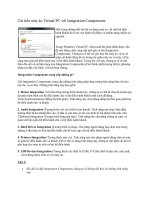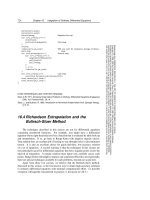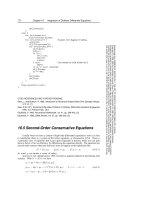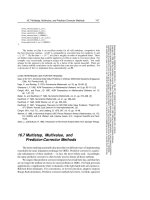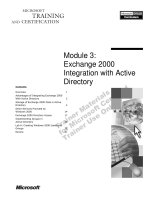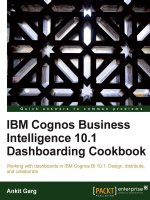Jenkins Continuous Integration Cookbook pdf
Bạn đang xem bản rút gọn của tài liệu. Xem và tải ngay bản đầy đủ của tài liệu tại đây (28.44 MB, 344 trang )
Jenkins Continuous
Integration Cookbook
Over 80 recipes to maintain, secure, communicate,
test, build, and improve the software development
process with Jenkins
Alan Mark Berg
BIRMINGHAM - MUMBAI
Jenkins Continuous Integration Cookbook
Copyright © 2012 Packt Publishing
All rights reserved. No part of this book may be reproduced, stored in a retrieval system, or
transmitted in any form or by any means, without the prior written permission of the publisher,
except in the case of brief quotations embedded in critical articles or reviews.
Every effort has been made in the preparation of this book to ensure the accuracy of the
information presented. However, the information contained in this book is sold without
warranty, either express or implied. Neither the author, nor Packt Publishing, and its dealers
and distributors will be held liable for any damages caused or alleged to be caused directly or
indirectly by this book.
Packt Publishing has endeavored to provide trademark information about all of the companies
and products mentioned in this book by the appropriate use of capitals. However, Packt
Publishing cannot guarantee the accuracy of this information.
First published: June 2012
Production Reference: 1080612
Published by Packt Publishing Ltd.
Livery Place
35 Livery Street
Birmingham B3 2PB, UK.
ISBN 978-1-849517-40-9
www.packtpub.com
Cover Image by Faiz Fattohi ()
Credits
Author
Alan Mark Berg
Reviewers
Dr. Alex Blewitt
Florent Delannoy
Michael Peacock
Acquisition Editor
Usha Iyer
Lead Technical Editor
Azharuddin Shaikh
Technical Editors
Merin Jose
Lubna Shaikh
Copy Editor
Brandt D'Mello
Project Coordinator
Leena Purkait
Proofreader
Jonathan Todd
Indexers
Tejal Daruwale
Hemangini Bari
Production Coordinator
Arvindkumar Gupta
Cover Work
Arvindkumar Gupta
About the Author
Alan Mark Berg, Bsc, MSc, PGCE, has been the lead developer at the Central Computer
Services at the University of Amsterdam for the last 12 years. In his famously scarce spare
time, he writes. Alan has a degree, two Master's, and a teaching qualication. He has also
co-authored two books about Sakai (
)—a highly successful
open source learning management platform used by many millions of students around the
world. Alan has also won a Sakai Fellowship.
In previous incarnations, Alan was a technical writer, an Internet/Linux course writer, a
product line development ofcer, and a teacher. He likes to get his hands dirty with the
building and gluing of systems. He remains agile by ruining various development and
acceptance environments.
I would like to thank Hester, Nelson, and Lawrence. I felt supported and
occasionally understood by my family. Yes, you may pretend you don't know
me, but you do. Without your unwritten understanding that 2 a.m. is a
normal time to work and a constant supply of sarcasm is good for my soul,
I would not have nished this or any other large-scale project.
Finally, I would like to warmly thank the Packt Publishing team, whose
consistent behind the scenes effort improved the quality of this book.
About the Reviewers
Dr. Alex Blewitt is a technical architect, working at an investment bank in London. He has
recently won an Eclipse Community Award at EclipseCon 2012 for his involvement with the
Eclipse platform over the last decade. He also writes for InfoQ and has presented at many
conferences. In addition to being an expert in Java, he also develops for the iOS platform, and
when the weather's nice, he goes ying. His blog is at , and
he can be reached via @alblue on Twitter.
Florent Delannoy is a French software engineer, now living in New Zealand after
graduating with honors from a MSc in Lyon. Passionate about open source, clean code,
and high quality software, he is currently working on one of New Zealand's largest domestic
websites with Catalyst I.T. in Wellington.
I would like to thank my family for their support and my colleagues
at Catalyst for providing an amazingly talented, open, and supportive
workplace.
Michael Peacock (www.michaelpeacock.co.uk) is an experienced senior/lead
developer and Zend Certied Engineer from Newcastle, UK, with a degree in Software
Engineering from the University of Durham.
After spending a number of years running his own web agency, managing the development
team, and working for Smith Electric Vehicles on developing its web-based vehicle telematics
platform, he currently serves as head developer for an ambitious new start-up: leading the
development team and managing the software development processes.
He is the author of Drupal 7 Social Networking, PHP 5 Social Networking, PHP 5 E-Commerce
Development, Drupal 6 Social Networking, Selling online with Drupal E-Commerce, and
Building Websites with TYPO3. Other publications in which Michael has been involved include
Mobile Web Development and Drupal for Education and E-Learning, both of which he acted as
technical reviewer for.
Michael has also presented at a number of user groups and conferences including PHPNE,
PHPNW10, CloudConnect, and ConFoo,
You can follow Michael on Twitter: www.twitter.com/michaelpeacock, or nd out more
about him through his blog: www.michaelpeacock.co.uk.
www.PacktPub.com
Support les, eBooks, discount offers, and more
You might want to visit www.PacktPub.com for support les and downloads related to
your book.
Did you know that Packt offers eBook versions of every book published, with PDF and ePub
les available? You can upgrade to the eBook version at
www.PacktPub.com and as a print
book customer, you are entitled to a discount on the eBook copy. Get in touch with us at
for more details.
At www.PacktPub.com, you can also read a collection of free technical articles, sign up
for a range of free newsletters and receive exclusive discounts and offers on Packt books
and eBooks.
Do you need instant solutions to your IT questions? PacktLib is Packt's online digital book
library. Here, you can access, read, and search across Packt's entire library of books.
Why Subscribe?
f Fully searchable across every book published by Packt
f Copy and paste, print, and bookmark content
f On demand and accessible via web browser
Free Access for Packt account holders
If you have an account with Packt at www.PacktPub.com, you can use this to access
PacktLib today and view nine entirely free books. Simply use your login credentials for
immediate access.
Table of Contents
Preface 1
Chapter 1: Maintaining Jenkins 7
Introduction 8
Using a sacricial Jenkins instance 9
Backing up and restoring 13
Modifying Jenkins conguration from the command line 18
Reporting overall disc usage 21
Deliberately failing builds through log parsing 24
A Job to warn about the disc usage violations through log parsing 27
Keeping in contact with Jenkins through Firefox 30
Monitoring through JavaMelody 32
Keeping a track of the script glue 36
Scripting the Jenkins command-line interface 37
Global modications of Jobs with Groovy 40
Signaling the need to archive 42
Chapter 2: Enhancing Security 45
Introduction 45
Testing for OWASP's top ten security issues 47
Finding 500 errors and XSS attacks in Jenkins through fuzzing 50
Improving security via small conguration changes 53
Looking at the Jenkins user through Groovy 56
Working with the Audit Trail plugin 58
Installing OpenLDAP with a test user and group 61
Using Script Realm authentication for provisioning 64
Reviewing project-based matrix tactics via a custom group script 67
Administering OpenLDAP 70
Conguring the LDAP plugin 74
ii
Table of Contents
Installing a CAS server 77
Enabling SSO in Jenkins 83
Chapter 3: Building Software 85
Introduction 85
Plotting alternative code metrics in Jenkins 88
Running Groovy scripts through Maven 93
Manipulating environmental variables 97
Running AntBuilder through Groovy in Maven 102
Failing Jenkins Jobs based on JSP syntax errors 106
Conguring Jetty for integration tests 111
Looking at license violations with RATs 114
Reviewing license violations from within Maven 117
Exposing information through build descriptions 121
Reacting to the generated data with the Post-build Groovy plugin 123
Remotely triggering Jobs through the Jenkins API 126
Adaptive site generation 129
Chapter 4: Communicating Through Jenkins 135
Introduction 136
Skinning Jenkins with the Simple Theme plugin 137
Skinning and provisioning Jenkins using a WAR overlay 140
Generating a home page 145
Creating HTML reports 148
Efcient use of views 151
Saving screen space with the Dashboard plugin 153
Making noise with HTML5 browsers 155
An eXtreme view for reception areas 158
Mobile presentation using Google Calendar 160
Tweeting the world 163
Mobile apps for Android and iOS 166
Getting to know your audience with Google Analytics 169
Chapter 5: Using Metrics to Improve Quality 173
Introduction 174
Estimating the value of your project through Sloccount 176
Looking for "smelly" code through code coverage 179
Activating more PMD rulesets 183
Creating custom PMD rules 188
Finding bugs with FindBugs 193
Enabling extra FindBugs rules 197
iii
Table of Contents
Finding security defects with FindBugs 199
Verifying HTML validity 203
Reporting with JavaNCSS 205
Checking style using an external pom.xml 207
Faking checkstyle results 210
Integrating Jenkins with Sonar 213
Chapter 6: Testing Remotely 217
Introduction 217
Deploying a WAR le from Jenkins to Tomcat 219
Creating multiple Jenkins nodes 222
Testing with Fitnesse 226
Activating Fitnesse HtmlUnit Fixtures 230
Running Selenium IDE tests 234
Triggering Failsafe integration tests with Selenium Webdriver 240
Creating JMeter test plans 244
Reporting JMeter performance metrics 246
Functional testing using JMeter assertions 249
Enabling Sakai web services 253
Writing test plans with SoapUI 256
Reporting SoapUI test results 259
Chapter 7: Exploring Plugins 265
Introduction 265
Personalizing Jenkins 267
Testing and then promoting 270
Fun with pinning JS Games 274
Looking at the GUI Samples plugin 277
Changing the help of the le system scm plugin 280
Adding a banner to Job descriptions 283
Creating a RootAction plugin 288
Exporting data 291
Triggering events on startup 293
Triggering events when web content changes 295
Reviewing three ListView plugins 297
Creating my rst ListView plugin 301
Appendix: Processes that Improve Quality 309
Avoiding group think 309
Considering test automation as a software project 310
Offsetting work to Jenkins nodes 311
iv
Table of Contents
Learning from history 311
Test frameworks are emerging 312
Starve QA/ integration servers 313
And there's always more 313
Final comments 314
Index 315
Preface
Jenkins is a Java-based Continuous Integration (CI) server that supports the discovery of
defects early in the software cycle. Thanks to over 400 plugins, Jenkins communicates with
many types of systems, building and triggering a wide variety of tests.
CI involves making small changes to software, and then building and applying quality
assurance processes. Defects do not only occur in the code but also appear in the naming
conventions, documentation, how the software is designed, build scripts, the process of
deploying the software to servers, and so on. Continuous integration forces the defects to
emerge early, rather than waiting for software to be fully produced. If defects are caught in
the later stages of the software development lifecycle, the process will be more expensive.
The cost of repair radically increases as soon as the bugs escape to production. Estimates
suggest it is 100 to 1000 times cheaper to capture defects early. Effective use of a CI server,
such as Jenkins, could be the difference between enjoying a holiday and working unplanned
hours to heroically save the day. As you can imagine, in my day job as a Senior Developer
with aspirations to Quality Assurance, I like long boring days, at least for mission-critical
production environments.
Jenkins can automate the building of software regularly, and trigger tests pulling in the results
and failing based on dened criteria. Failing early through build failure lowers the costs, increases
condence in the software produced, and has the potential to morph subjective processes into
an aggressive metrics-based process that the development team feels is unbiased.
The following are the advantages of Jenkins:
f It is proven technology that is deployed at a large scale in many organizations.
f It is an open source technology, so the code is open to review and has no
licensing costs.
f It has a simple conguration through a web-based GUI, which speeds up Job creation,
improves consistency, and decreases the maintenance costs.
f It is a master slave topology that distributes the build and testing effort over slave
servers with the results automatically accumulated on the master. This topology
ensures a scalable, responsive, and stable environment.
Preface
2
f It has the ability to call slaves from the cloud. Jenkins can use Amazon
services or an Application Service Provider (ASP), such as CloudBees
( /> f There is no fuss in installation, as installation is as simple as running only a single
download le named jenkins.war.
f It has over 400 plugins supporting communication, testing, and integration to
numerous external applications
( /> f It is a straightforward plugin framework—for Java programmers, writing plugins is
straightforward. Jenkins plugin framework has clear interfaces that are easy to
extend. The framework uses Xstream for persisting conguration information as XML
( and Jelly for the creation of parts of the GUI
( /> f It has the facility to support running Groovy scripts, both in the master and remotely
on slaves. This allows for consistent scripting across operating systems. However, you
are not limited to scripting in Groovy. Many administrators like to use Ant, Bash, or
Perl scripts.
f Though highly supportive of Java, Jenkins also supports other languages.
f Jenkins is an agile project; you can see numerous releases in the year, pushing
improvements rapidly (
There is also a
highly stable long-term support release for the more conservative. Hence, there is a
rapid pace of improvement.
f Jenkins pushes up code quality by automatically testing within a short period after
code commit, and then shouting loudly if build failure occurs.
Jenkins is not just a continual integration server but also a vibrant and highly active
community. Enlightened self-interest dictates participation. There are a number of
ways to do this:
f Participate on the Mailing lists and Twitter
(
First, read the postings, and as you get to understand what is needed, participate
in the discussions. Consistently reading the lists will generate many opportunities
to collaborate.
f Improve code, write plugins
( /> f Test Jenkins, especially the plugins, and write bug reports, donating your test plans.
f Improve documentation by writing tutorials and case studies.
f Sponsor and support events.
Preface
3
What this book covers
Chapter 1, Maintaining Jenkins, describes common maintenance tasks, such as backing up
and monitoring.
Chapter 2, Enhancing Security, details how to secure Jenkins and the value of enabling Single
Sign On (SSO).
Chapter 3, Building Software, explores the relationship between Jenkins builds and the Maven
pom.xml le.
Chapter 4, Communicating Through Jenkins, reviews effective communication strategies for
different target audiences, from developers and project managers to the wider public.
Chapter 5, Using Metrics to Improve Quality, explores the use of source code metrics.
Chapter 6, Testing Remotely, details approaches to set up and run remote stress and
functional tests.
Chapter 7, Exploring Plugins, reviews a series of interesting plugins and shows how easy it is
to create your rst plugin.
Appendix, Processes That Improve Quality, discusses how the recipes in this book support
quality processes.
What you need for this book
This book assumes you have a running an instance of Jenkins.
In order to run the recipes provided in the book, you need to have the following software:
Recommended
f Maven 2: /> f Jenkins: /> f Java version 1.6: />Optional
f VirtualBox: /> f SoapUI: /> f JMeter: />Helpful
f A local subversion repository
f OS of preference: Linux/Ubuntu
Preface
4
There are numerous ways to install Jenkins: as a Windows service, using the repository
management features of Linux such as apt and yum, using Java Web Start, or running
directly from a WAR le. It is up to you to choose the approach that you feel is most
comfortable. However, you could run Jenkins from a WAR le using HTTPS from the
command line, pointing to a custom directory. If any experiments go astray, then you
can simply point to another directory and start fresh.
To use this approach, rst set the environment variable
JENKINS_HOME to the directory you
wish Jenkins to run under. Next, run a command similar to the following:
Java –jar jenkins.war –httpsPort=8443 –httpPort=-1
Jenkins will start to run over https on port 8443. The http port is turned off by setting
httpPort=-1, and the terminal will display logging information.
You can ask for help through the following command:
Java –jar jenkins.war –help
A wider range of installation instructions can be found at
/>For a more advanced recipe describing how to set up a virtual image under VirtualBox
with Jenkins, you can use the Using a sacricial Jenkins instance recipe in Chapter 1,
Maintaining Jenkins.
Who this book is for
This book is for Java developers, software architects, technical project managers, build
managers, and development or QA engineers. A basic understanding of the Software
Development Life Cycle, some elementary web development knowledge, and basic application
server concepts are expected to be known. A basic understanding of Jenkins is also assumed.
Conventions
In this book, you will nd a number of styles of text that distinguish between different kinds of
information. Here are some examples of these styles and an explanation of their meaning.
Code words in text are shown as follows: "On the host OS, create a directory named
workspacej."
A block of code is set as follows:
<?xml version='1.0' encoding='UTF-8'?>
<org.jvnet.hudson.plugins.thinbackup.ThinBackupPluginImpl>
<fullBackupSchedule>1 0 * * 7</fullBackupSchedule>
<diffBackupSchedule>1 1 * * *</diffBackupSchedule>
Preface
5
<backupPath>/home/aberg/backups</backupPath>
<nrMaxStoredFull>61</nrMaxStoredFull>
<cleanupDiff>true</cleanupDiff>
<moveOldBackupsToZipFile>true</moveOldBackupsToZipFile>
<backupBuildResults>true</backupBuildResults>
<excludedFilesRegex></excludedFilesRegex>
</org.jvnet.hudson.plugins.thinbackup.ThinBackupPluginImpl>
When we wish to draw your attention to a particular part of a code block, the relevant lines or
items are set in bold:
#!/usr/bin/perl
use File::Find;
my $content = "/var/lib/jenkins";
my $exclude_pattern = '^.*\.(war)|(class)|(jar)$';
find( \&excluded_file_summary, $content );
sub excluded_file_summary {
if ((-f $File::Find::name)&&( $File::Find::name
=~/$exclude_pattern/)){
print "$File::Find::name\n";
}
}
Any command-line input or output is written as follows:
mvn license:format -Dyear=2012
New terms and important words are shown in bold. Words that you see on the screen,
in menus or dialog boxes for example, appear in the text like this: "Within the VirtualBox,
right-click on the Ubuntu image, selecting properties."
Warnings or important notes appear in a box like this.
Tips and tricks appear like this.
Reader feedback
Feedback from our readers is always welcome. Let us know what you think about this
book—what you liked or may have disliked. Reader feedback is important for us to
develop titles that you really get the most out of.
Preface
6
To send us general feedback, simply send an e-mail to ,
and mention the book title through the subject of your message.
If there is a topic that you have expertise in and you are interested in either writing or
contributing to a book, see our author guide on
www.packtpub.com/authors.
Customer support
Now that you are the proud owner of a Packt book, we have a number of things to help you to
get the most from your purchase.
Downloading the example code
You can download the example code les for all Packt books you have purchased from your
account at . If you purchased this book elsewhere, you can
visit and register to have the les e-mailed directly
to you.
Errata
Although we have taken every care to ensure the accuracy of our content, mistakes do happen.
If you nd a mistake in one of our books—maybe a mistake in the text or the code—we would be
grateful if you would report this to us. By doing so, you can save other readers from frustration
and help us improve subsequent versions of this book. If you nd any errata, please report
them by visiting selecting your book, clicking on
the errata submission form link, and entering the details of your errata. Once your errata are
veried, your submission will be accepted and the errata will be uploaded to our website, or
added to any list of existing errata, under the Errata section of that title.
Piracy
Piracy of copyright material on the Internet is an ongoing problem across all media. At Packt,
we take the protection of our copyright and licenses very seriously. If you come across any
illegal copies of our works, in any form, on the Internet, please provide us with the location
address or website name immediately so that we can pursue a remedy.
Please contact us at with a link to the suspected pirated material.
We appreciate your help in protecting our authors and our ability to bring you valuable content.
Questions
You can contact us at if you are having a problem with any
aspect of the book, and we will do our best to address it.
1
Maintaining Jenkins
This chapter provides recipes that help you to maintain the health of your Jenkins server.
In this chapter, we will cover the following recipes:
f Using a sacricial Jenkins instance
f Backing up and restoring
f Modifying the Jenkins conguration from the command line
f Reporting about the overall disc usage
f Deliberately failing builds through log parsing
f A Job to warn about the disc usage violations
f Keeping in contact with Jenkins through Firefox
f Monitoring through JavaMelody
f Keeping a track of the script glue
f Scripting the Jenkins command-line interface
f Global modications of Jobs with Groovy
f Signaling the need to archive
Maintaining Jenkins
8
Introduction
Jenkins is feature-rich and is vastly extendable through plugins. Jenkins talks with numerous
external systems, and its Jobs work with many diverse technologies. Maintaining Jenkins in a
rich environment is a challenge. Proper maintenance lowers the risk of failures, a few of which
are listed as follows:
f New plugins causing exceptions: There are a lot of good plugins being written with
a rapid version change. In this situation, it is easy for you to accidentally add new
versions of the plugins with new defects. There have been a number of times when
the plugin suddenly stopped working, while it was being upgraded. To combat the risk
of plugin exceptions, consider using a sacricial Jenkins instance before releasing to
a critical system.
f Disks overowing with artifacts: If you keep a build history, which includes artifacts
such as war les, large sets of JAR les or other types of binaries, then your disk
space is consumed at a surprising rate. Disc costs have decreased tremendously, but
disk usage equates to longer backup times and more communication from the slave
to the master. To minimize the risk of disk overowing, you will need to consider your
backup and restore policy and the associated build retention policy expressed in the
advanced options of Jobs.
f Script spaghetti: As Jobs are written by various development teams, the location and
style of the included scripts vary. This makes it difcult for you to keep track. Consider
using well-dened locations for your scripts, and a scripts repository managed
through a plugin.
f Resource depletion: As memory is consumed, or the number of intense Jobs
increase, Jenkins slows down. Proper monitoring and quick reaction reduce their
impact.
f A general lack of consistency between Jobs due to organic growth: Jenkins is easy
to install and use. The ability to seamlessly turn on plugins is addictive. The pace of
adoption of Jenkins within an organization can be breathtaking. Without a consistent
policy, your teams will introduce lots of plugins and lots of ways of performing the
same work. Conventions improve the consistency and readability of Jobs and thus
decrease the maintenance.
The recipes in this chapter are designed to address the risks mentioned. They represent
only one set of approaches. If you have comments or improvements, feel free to contact me
through my Packt Publishing e-mail address, or it would even be better if you still add tutorials
to the Jenkins community wiki.
Chapter 1
9
Signing up to the community
To add community bug reports, or to modify wiki pages, you will need to
create an account at the following URL:
/>Issue+Tracking
Using a sacricial Jenkins instance
Continuous Integration (CI) servers are critical in the creation of deterministic release cycles.
Any long-term instability in the CI server will reect in the milestones of your project plans.
Incremental upgrading is addictive and mostly straightforward, but should be seen in the light
of the Jenkins wider role.
Before the release of plugins into the world of your main development cycle, it is worth
aggressively deploying to a sacricial Jenkins instance, and then sitting back and letting the
system run the Jobs. This gives you enough time to react to any minor defects found.
There are many ways to set up a sacricial instance. One is to use a virtual image of Ubuntu
and share the workspace with the Host server (the server that the virtual machine runs on).
There are a number of advantages to this approach:
f Saving state: At any moment, you can save the state of the running virtual image
and return to that running state later. This is excellent for short-term experiments that
have a high risk of failure.
f Ability to share images: You can run your virtual image anywhere that a player can
run. This may include your home desktop or a hard core server.
f Use a number of different operating systems: Good for node machines running
integration tests or functional tests with multiple browser types.
f Swap workspaces: By having the workspace outside the virtual image, you can
test different version levels of the OS against one workspace. You can also test one
version of Jenkins against different workspaces, with different plugin combinations.
The long-term support release
The community manages support of the enterprise through the release
of a long-term supported version of Jenkins. This stable release version is
older than the newest version and thus misses out on some of the newer
features. You can download it from: kins-ci.
org/war-stable/latest/jenkins.war.
Maintaining Jenkins
10
This recipe details the use of VirtualBox ( an open source
virtual image player with a guest Debian OS image. The virtual image will mount a directory
on the host server. You will then point Jenkins to the mounted directory. When the guest OS is
restarted, it will automatically run against the shared directory.
Throughout the rest of this book, recipes will be cited using
Ubuntu as the example OS.
Getting ready
You will need to download and install VirtualBox. You can nd the detailed instructions at
To download and unpack a Ubuntu virtual
image, you can refer to the following URL: />virtualboximage/files/Ubuntu%20Linux/11.04/ubuntu_11.04-x86.7z/
download
.
Note that the newer images will be available at the time of reading. Feel free to try the most
modern version; it is probable that the recipes might still work.
Security considerations
If you consider using other OS images a bad security practice, then
you should create a Ubuntu image from a boot CD as mentioned at:
/>How to do it
1. Run VirtualBox and click on the New icon in the top-left hand corner. You will now see
a wizard for installing virtual images.
2. On the Welcome screen, click on the Next button.
3. Set the Name to Jenkins_Ubuntu_11.04. The OS Type will be automatically
updated. Click on the Next button.
4. Set Memory to 2048 MB, and click on Next.
5. Select Use existing hard disk. Browse and select the unpacked VDI image by clicking
on the folder icon.
6. Press the Create button.
Chapter 1
11
7. Start the virtual image by clicking on the Start icon.
8. Log in to the guest OS with username and password as Ubuntu reverse.
9. Change the password of user Ubuntu from a terminal.
passwd
10. Install the Jenkins repository, as explained at />debian/
.
11. Update the OS in case of security patches (this may take some time depending
on bandwidth):
apt-get update
apt-get upgrade
12. Install the kernel dkms module.
sudo apt-get install dkms
13. Install Jenkins.
sudo apt-get install jenkins
14. Install the kernel modules for VirtualBox.
/etc/init.d/vboxadd setup
15. Select Install Guest additions using the Devices menu option.
16. Add the Jenkins user to the vboxsf group.
sudo gedit /etc/group
vboxsf:x:1001:Jenkins
Maintaining Jenkins
12
17. Modify the JENKINS_HOME variable in /etc/default/Jenkins to point to the
mounted shared directory:
sudo gedit /etc/default/Jenkins
JENKINS_HOME=/media/sf_workspacej
18. On the host OS, create the directory workspacej.
19. Within the VirtualBox, right-click on the Ubuntu image, selecting properties.
20. Update the Folder Path to point to the directory that you have previously created. In
the following screenshot, the folder was created under my home directory.
21. Restart VirtualBox, and start the Ubuntu Guest OS.
22. On the Guest OS, run a web browser, and visit http://localhost:8080. You will
see a locally running instance of Jenkins, ready for your experiments.
How it works
Your recipe rst installs a virtual image of Ubuntu, changes the password so that it is harder
for others to log in, and updates the guest OS for security patches.
The Jenkins repository is added to the list of known repositories in the Guest OS. This involved
locally installing a repository key. The key is used to verify that the packages, which are
automatically downloaded, belong to a repository that you have agreed to trust. Once the trust
is enabled, you can install through standard package management the most current version
of Jenkins, and aggressively update it later.
